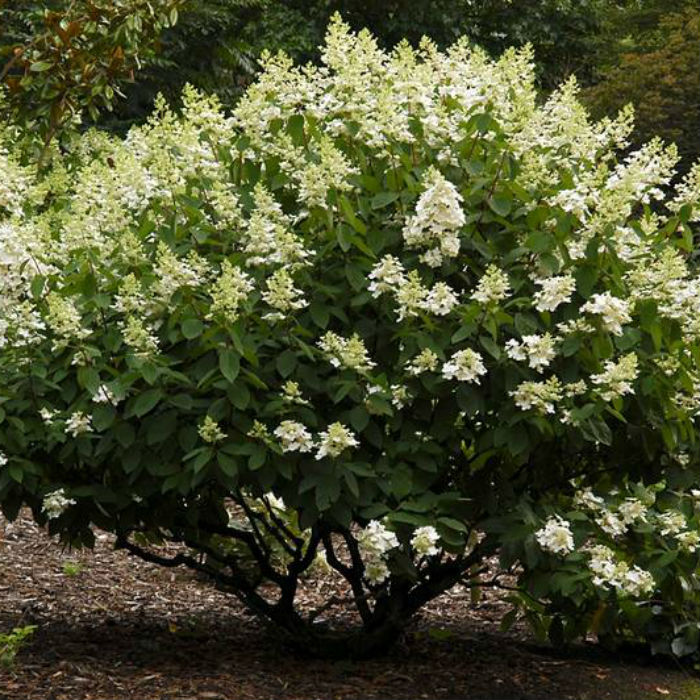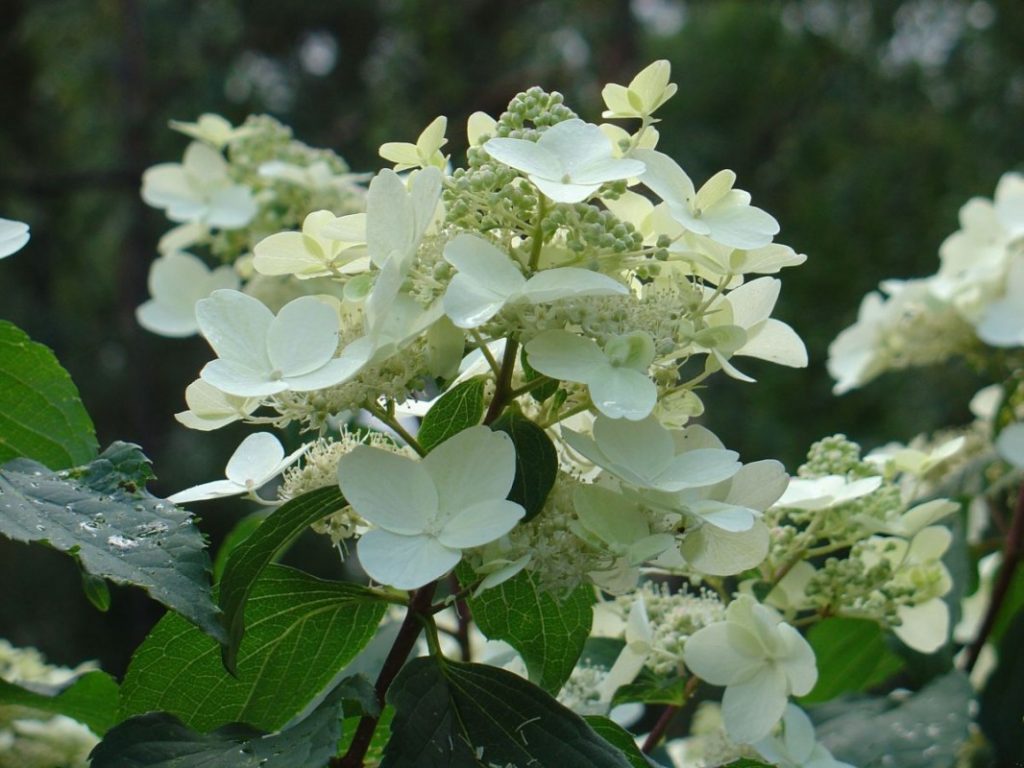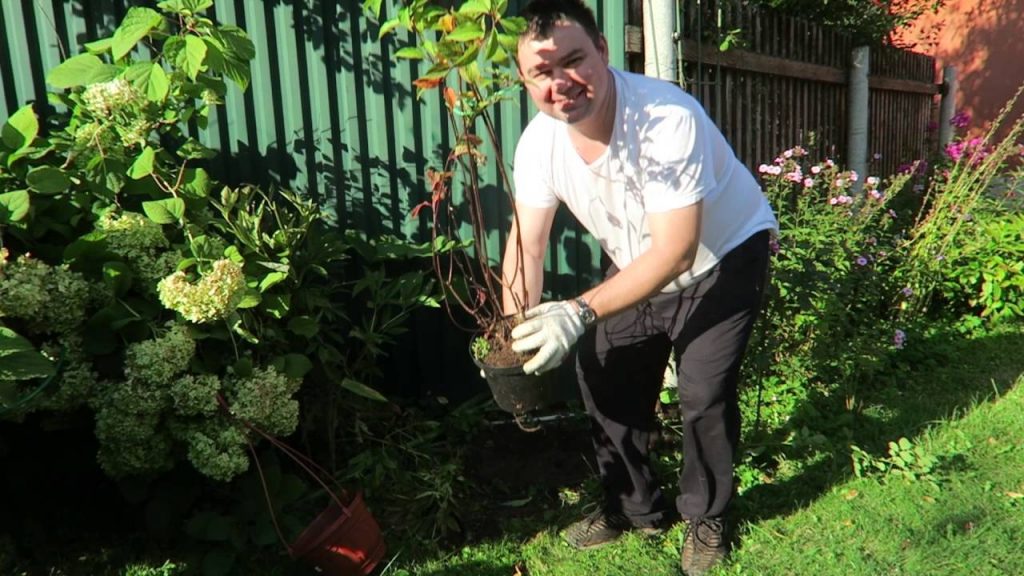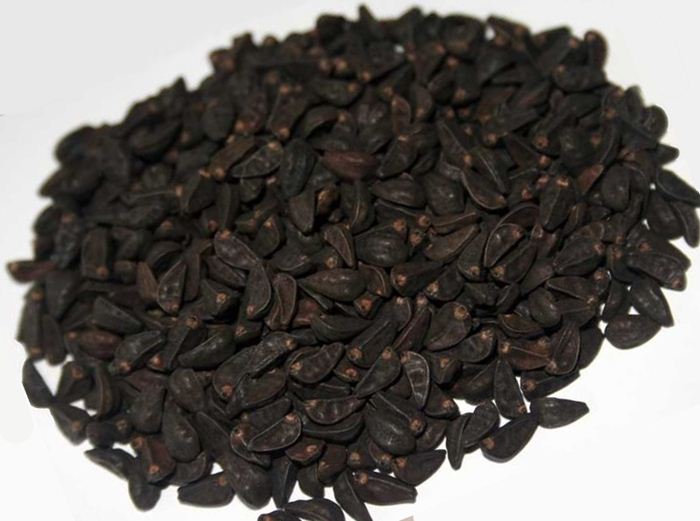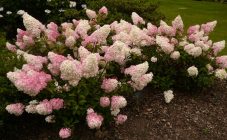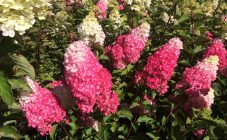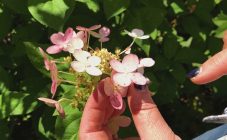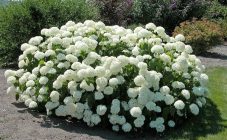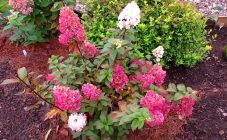Content:
In the spring, this green bush is completely inconspicuous. But with the onset of summer and until late autumn, having dismissed its delicate snow-white flowers, it becomes a true decoration of the garden.
Characteristic
The plant belongs to the species Hydrangea paniculata of the genus Hydrangea of the Hortensia family. Form - deciduous shrub. It grows on any soil, except clean sand and swamps, but still preferring acidic soil. It tolerates light shade and partial shade well. In direct sunlight it loses its luxurious decorative look. Distinctive features of the variety of Hydrangea paniculata Kyushu:
- The root system is superficial, sensitive to damage. The size exceeds the crown of the bush in an adult state.
- Branches are upright, rigid, red-brown in color. Crown diameter up to 3 meters.
- The leaves are elliptical, green in color with red petioles.
- The flowers are fragrant, white. They form loose cone-shaped inflorescences 20-35 cm long. By autumn they can acquire a slightly pinkish tint.
- The fruit is a capsule 1-3 mm. Seeds - small, numerous
- Propagated by seeds, cuttings, layering. Rooting twigs are flexible when pruning plants in spring, or from June 10 to 15.
- The culture is characterized by winter hardiness and at the same time moisture-loving.
Description of the variety Hydrangea Kyushu
Published records of archaeological excavations in Japan, South and East Asia, North and South America, China suggest that the Hortensia family is an ancient representative of the flora. The variety is often called Kuishi Hydrangea or Japanese Hydrangea, although in the historical homeland of culture, Kyushu Ajisai is pronounced.
As an ornamental plant, such a variety as panicle hydrangea was brought to Europe in 1829 from Japan by the German naturalist, researcher of the land of the rising sun, physician Philip Franz von Siebold. Somewhat later, in the same place, in Europe, the variety Hortensia paniculata Kiushu was cultivated.
Mature bushes reach a height of three meters. Branches of red-brown and brown color, looking through the emerald-green leaves, give the plant a special sophistication and beauty. The decorativeness is added by leaf stalks to match the branches. Fragrant white flowers, gathered in a cone-shaped panicle, cover the entire crown, reaching 2-3 meters in diameter. The spreading form of a shrub, resembling a fan, looks spectacular in the garden. By using the pruning method, you can achieve various forms of the bush.
The signs of the variety in the acquired bush may not appear immediately. Hydrangea Kyushu will reveal its full beauty with proper care a few years after planting.
Planting hydrangeas
The recommended planting time is spring, as soon as the ground thaws and warms up. In the southern regions of Russia, it can be planted in the ground in spring and autumn. Plants with a well-formed root system can be planted in mid or late September. Young seedlings are best planted in the spring.
Choosing a landing site
Hydrangea Kyushu is a light-loving plant, but it does not tolerate direct sunlight well. In addition, the soil dries out quickly in the open sun, which is unacceptable for the growth of a healthy bush.However, by placing it in a dense shade, you can not wait for flowering. When choosing a place for a plant, it is worth considering:
- Daylight. Hortense loves light most of the day.
- Distance to nearby trees. Close proximity should be avoided, otherwise competition for moisture and nutrition is inevitable.
- Windproof. An important factor due to the fragility and fragility of the shoots in seedlings.
Soil preparation
A place for a hydrangea is prepared in a few days so that the soil subsides a little. In a pit 40 cm deep and 50 by 60 cm wide, they place:
- drainage (broken brick, crushed stone, expanded clay) in 6-8 cm;
- superphosphate (60 g);
- potash fertilizers (20 g);
- nitrogen fertilizers for spring planting (20 g);
- peat (depends on acidity, the lower it is, the greater the proportion);
- humus (8-10 kg)
Clay is added to the sandy soil in a layer of 3-4 cm.
Landing
Recommended distance between planting pits:
- with a single planting (up to neighboring plants) - 1-1.5 meters;
- hedge - 70-90 cm (so that the bushes do not drown out each other, thinning pruning is required once a year);
- standard forms - not less than two meters.
The roots of the shrub are pruned slightly to stimulate growth. When planting in the spring, annual shoots are also shortened to the level of 3-4 buds. The seedling is buried, sprinkling the root collar of 2-3 cm of soil. After abundant watering, the ground will settle slightly and the neck will remain at surface level. Further, the trunk circles are mulched with a layer of 5-8 cm of peat or wood chips, needles, walnut husks or straw.
Breeding varieties
Panicle hydrangea reproduces in several ways:
- Seeds. In a mixture of leafy earth, peat and sand (4: 2: 1), the seed is lowered, lightly sprinkled with the same composition, moistened by spraying and covered with transparent material to create a greenhouse effect. The seedbed must always be moist. Seedlings appear in 1-1.5 months. At this point, you can shoot the shelter. At the stage of cotyledonous leaf formation, the plants dive. When three or four permanent leaves appear, the pick is repeated, while the plants are transferred to separate pots of small diameter. From this moment, hardening is carried out, taking out into fresh air during the day, out of access to a draft and direct sunlight. At home, the sprout is 2 years old, and then in the spring it is transplanted into the garden to the beds for strengthening and growing. The seedling takes on a permanent place at the age of 3-5 years. Paniculate varieties do not tolerate frequent transplanting.
- Cuttings. Young twigs of a plant with several buds are used. They are placed in a container with water until roots are formed, and then transplanted into the soil. If the stalk is immediately planned to be rooted by planting in the ground, the lower leaves are cut off completely, the upper ones - half for photosynthesis in the stalk. A small seedling is covered with a dome, creating a greenhouse effect. After a month and a half, when the stalk takes root, the shelter can be removed. The seedling should be ventilated once a week for about an hour and the soil should be kept moist.
- Layers. Given the fragility and sensitivity of the root system of this hydrangea variety to various damage, reproduction should be carried out carefully. In the spring, the soil around the bush is loosened and a depression is made 3-5 cm wide. Before the buds bloom, the lower shoot of the bush is laid in it, sprinkled with earth and fixed in such a position so that it does not rise. The top of the branch is left above the ground, tied upright to the support. When the lateral vertical shoots that have appeared reach 20 cm, hilling is carried out. As the stem grows, the hilling is repeated. By the fall, the shoots have their roots. At this time or in spring, they can be separated from the mother bush and assigned to the garden to strengthen the root system.
Care of hydrangea paniculata Kiushu
Observing simple rules of care, you can achieve exuberant and long-lasting flowering:
- The plant requires annual pruning for beautiful and healthy flowering. The branches are shortened in autumn after flowering or before the growing season in spring. Leave from 3 to 4 buds. If necessary, they also perform sanitary pruning of bushes.
- In order to avoid drying out the soil and to protect against pests, the bushes of the culture are mulched with needles, wood chips, chopped straw, and walnut husks.
- Watering should be regular, preferably in the morning. The shrub does not tolerate drought, but easily withstands prolonged stagnation of water.
- The plant requires many nutrients for growth and flowering. Responsive to green fertilizers (nettle infusion), mullein and mineral fertilizers. Fertilizer application - once every two weeks.
Diseases, pests and means of their control
Subject to the growing conditions, panicle hydrangea Kyushu is resistant to diseases and rarely becomes a victim of pests. Particular attention should be paid to prevention:
- an excess of humus and lime in the soil is unacceptable, this will lead to the development of chlorosis (expressed in the yellowness of the leaves) - a solution of potassium nitrate and iron sulfate is recommended for treatment according to the instructions for the preparations;
- high humidity of the air and soil causes powdery mildew (dark spots appear on the leaves) - spray with a solution of copper sulfate and green soap (15 and 150 g, respectively) on 10 liters of water;
- insufficient air humidity contributes to the appearance of spider mites and aphids - for treatment, use insecticides according to the instruction scheme or a solution of laundry soap.
Hydrangea paniculata Kiushu is resistant to gas and smoke. This property and, of course, the beauty of the culture itself is successfully used in city parks and gardens.
